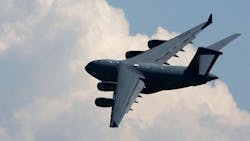Lockheed Looks Past Oil Slump for Payoff From Sikorsky Deal
Lockheed Martin Corp. knew that falling oil prices would dent drillers’ demand for Sikorsky helicopters as it paid $9 billion for the storied manufacturer last year. It just didn’t anticipate the extent of the crude collapse, CEO Marillyn Hewson said in an interview.
While depressed commercial sales are taking some of the shine off the Sikorsky deal as the U.S. rig count falls to a record low, Lockheed sees new opportunities to land military orders in Germany, Poland and Saudi Arabia. The acquisition is also expanding Lockheed’s international reach.
“We bought them for the long haul,” Hewson said Tuesday on the sidelines of the company’s media day briefings in Arlington, Va. “It’s a bit depressed right now. We took that into account in the business case when we bought them. We subsequently had to take that business case down a little more, because we didn’t know it was going to be as protracted.”
The world’s largest defense contractor is undergoing a year of transition as it absorbs Sikorsky and takes charge of programs to develop the largest U.S. military helicopter, a version to ferry U.S. presidents, and a new combat search-and-rescue craft. Lockheed is also preparing to spin off an information technology unit to Leidos Holdings Inc.
“They have a lot going on,” Doug Rothacker, a defense analyst at Bloomberg Intelligence, said of Lockheed’s restructuring. “Everyone is trying to get a look at what Lockheed will be going forward.”
Sikorsky is a better fit for Lockheed, which is already the biggest manufacturer of military aircraft including planes, Hewson said. Her company’s F-35 fighter program is the Pentagon’s largest weapons system with a $390 billion price tag. The purchase from United Technologies Corp. closed late last year.
“We did not anticipate that UTC was going to put Sikorsky on the market,” Hewson said. “When it did, we were ready, because we had looked at Sikorsky for many years.”
The helicopter maker, with about $5 billion in sales, is a “longer-cycle” business that fits well with Lockheed’s other aircraft platforms, Hewson said. Selling services to customers provides another steady revenue stream, and a backlog of almost $16 billion.
The IT division, which also has about $5 billion in sales, is less protected from potential competitors and only has about a year of work on backlog.
Lockheed studied alternatives for the business for about two years, Hewson said. It concluded that the unit, once one of the company’s fastest-growing areas, couldn’t be turned around in a contracting environment that prized low costs over past performance.
While Sikorsky’s orders for military helicopters face pressure from possible budget cuts in the U.S., Lockheed is working to land new international clients. Sikorsky’s Polish plant is now Lockheed’s biggest overseas factory. The company sees opportunities to sell the Black Hawk helicopter in Poland and Saudi Arabia. It may also find buyers for medium- to heavy-lift helicopters in Germany.
“That’s the reshaping of our portfolio that I think sets us up well to grow,” Hewson said.
By Julie Johnsson
About the Author
Bloomberg
Licensed content from Bloomberg, copyright 2016.
